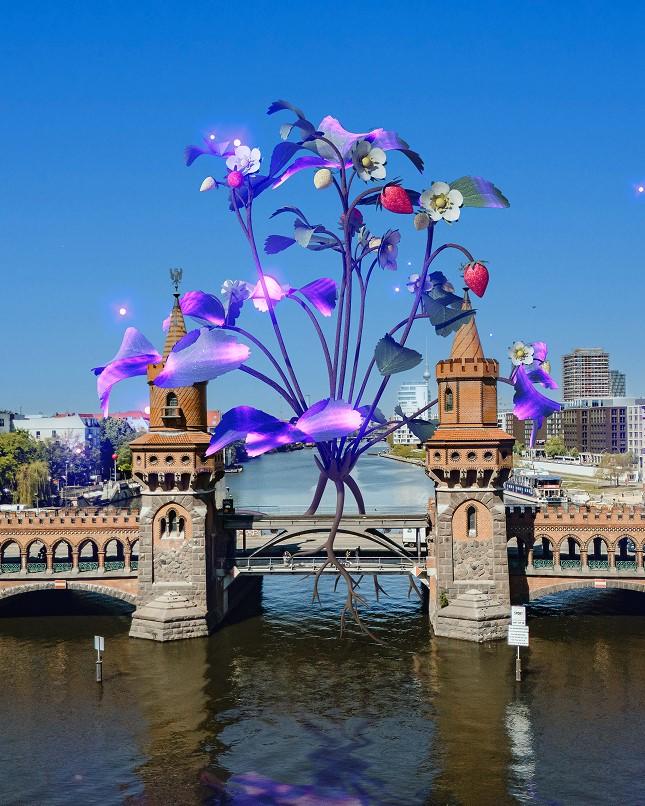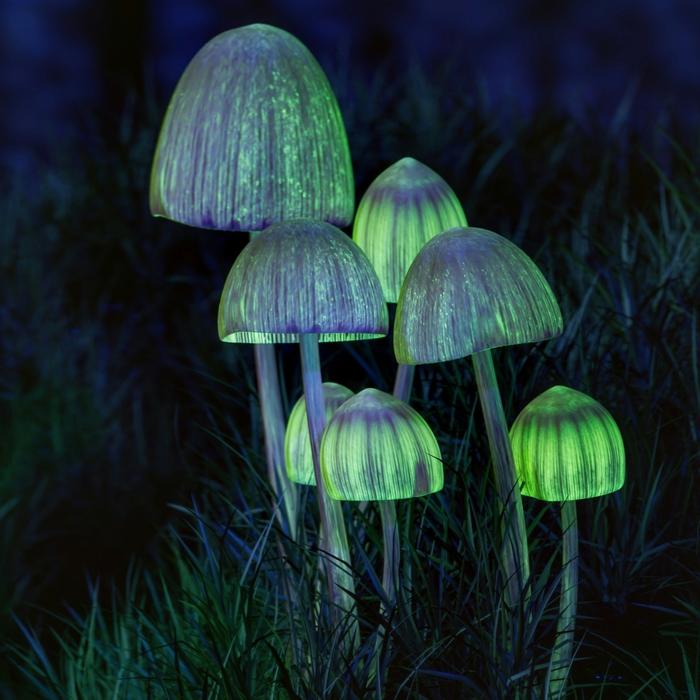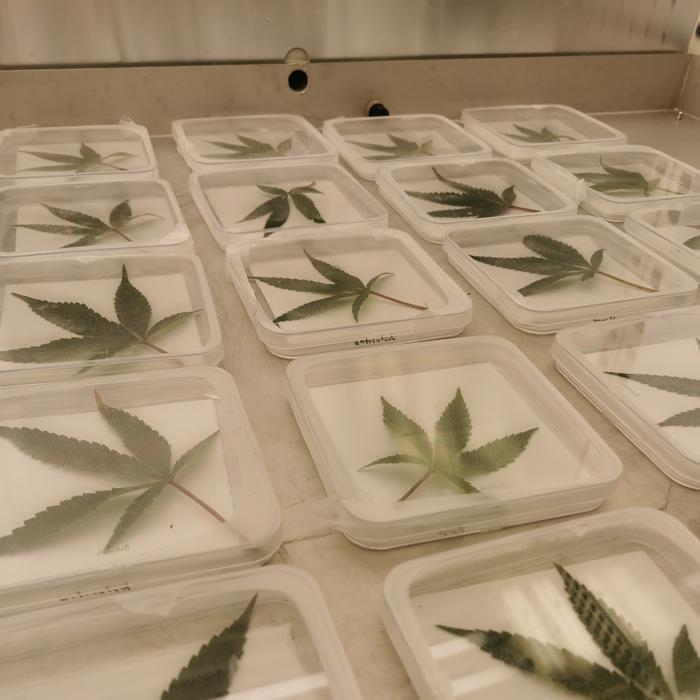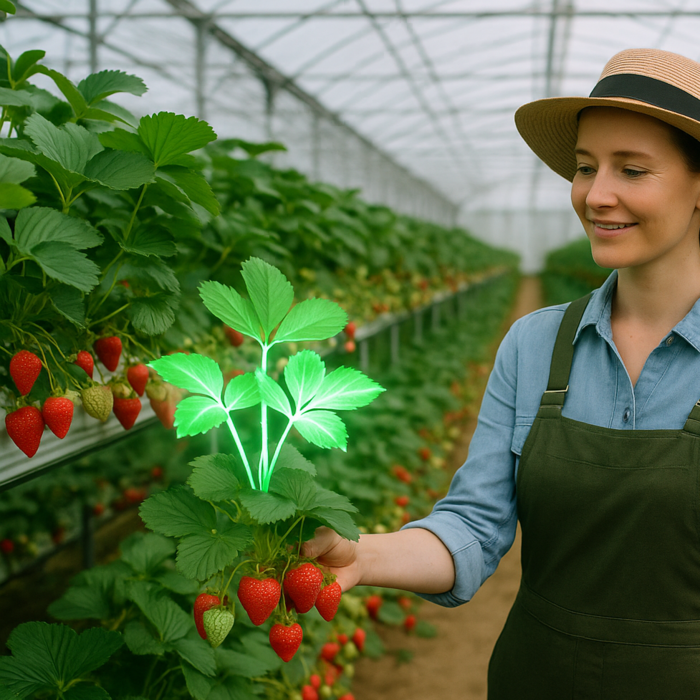And suddenly, the greenhouse plant lights up...
Tiziana Guerra is one of the five winners of our “Art Meets Science” ideas competition. She won in the Responsible Innovation category.
Tiziana Guerra is developing an early warning system at the Free University of Berlin that enables plants to alert us to infections—visibly.
Fungal infections are among the greatest threats to plant cultivation—often they are discovered too late to prevent crop losses. Especially in sensitive crops such as medicinal cannabis, they can cause enormous economic and qualitative damage.
This is exactly where LUMICAN comes in: an innovative early warning system developed by Tiziana Guerra and her research group as part of the “New Products for the Bioeconomy” ideas competition. The idea: using gene scissors and fluorescent reporter systems, so-called indicator plants are modified in such a way that they react particularly early to the occurrence of the widespread pathogen Botrytis cinerea, also known as gray mold, and glow visibly when infected. This allows infected plants in the greenhouse to be quickly identified before the fungus spreads further.
LUMICAN aims to provide a cost-effective, scalable, and sustainable solution that will make it easier for small and medium-sized farms in particular to access precise plant protection. This is made possible by combining molecular biology expertise, CRISPR-Cas technology, and a practical focus on transfer. We recognized Tiziana for this approach in our “Art Meets Science” ideas competition in the field of innovation and transfer.
In this interview, she talks about why science needs to get out of the lab, why the conditions for innovation in Berlin are great, and why a glowing strawberry plant is not just a pretty picture, but could be a real game changer for plant cultivation.
Dear Tiziana, congratulations on winning the BUA ideas competition in the field of innovation and transfer. What motivated you to take part in the ideas competition?
During the pandemic, it became clear to me how little knowledge from research actually reaches the general public. This leads to fears, conspiracy theories, and rejection. Many people are unaware of what research is already capable of today. We scientists tend to rarely leave our own world and present complex relationships as “too complicated to explain.” I am incredibly happy that people like Dr. Mai Thi Nguyen-Kim are showing how science communication works and that there is an audience for it.
What exactly is an indicator plant?
Traditionally, indicator plants are plant species that grow particularly well under certain conditions and thus indicate soil properties. One example is the stinging nettle, which grows particularly frequently on nitrogen-rich soils and is therefore considered an indicator of nutrient-rich locations. This principle is applied in viticulture, for example. Here, roses indicate the presence of mildew, as they are much more susceptible than the surrounding grapevines and therefore become diseased earlier and more clearly. Winegrowers are thus warned and can react more quickly.
We want to make this principle usable for the indoor cultivation of fruit, vegetables, and medicinal cannabis. To do this, we use the CRISPR-Cas gene scissors to make the crop more susceptible and to introduce a specific reporter.
This makes the plants susceptible, similar to roses in viticulture, except that in this case it is strawberries in strawberry cultivation or tomatoes in tomato cultivation. In addition, the plant begins to glow when infested.
How do you make them glow?
From basic research, we know which genes are activated within a few hours of infestation by certain fungi, bacteria, or insects. The “control unit” of such a gene is called a promoter. If the gene behind the promoter is replaced with a so-called reporter, it is activated when infested. Reporters are often used in research to better study the activity of genes. A plant is made to glow by selecting this reporter from a gene cluster of, for example, bioluminescent fungi.
What are the advantages of your approach to controlling fungal infestation? What is innovative about it?
My approach enables automated, visual monitoring of a plant culture, which contributes to plant protection in a cost-effective and simple way. The molecular indicator plant is included in the culture and clearly shows the infestation before the first symptoms appear, giving the farmer a head start. He can contain the infestation, minimize losses, and carry out precise plant protection.
“Responsible innovation” is one of the BUA's grand challenges. What makes an innovation responsible?
We use the latest research findings and methods to prevent crop losses quickly and precisely. Reducing pesticides and increasing germ-free, healthy food contributes to maintaining food production and safety.
You conduct research on medical cannabis, but also on strawberries and tomatoes. Does your early warning system work better for certain plants than for others?
We are currently limited to plants that can be genetically modified. Due to the legal situation in Europe, closed indoor cultures are also a prerequisite.
Keyword transfer: How do you make the transition from the laboratory to practical application? Where are you at right now?
We are currently creating pilot plants that will first be tested under controlled laboratory conditions and later in greenhouse cultures. We are in close contact with growers who are already looking forward to the pilot plants and want to test them together with us. Even though green genetic engineering is rather unpopular in Europe, growers see its great potential.
The principle of luminous indicator plants can also be applied to strawberry cultivation | ChatGPT | Tiziana Guerra
Our indicator plants serve as a bridge to such new technologies. They are transgenic, but are not consumed themselves. However, the technology behind them can be used without consumers having to fear (unfounded) genetic engineering in the end product.
How do you expect your research to be applied in 5 years?
My hope is that indicator plants will become established in greenhouse cultivation, enabling us to make food production safer and more sustainable. The principle can be applied to all indoor plants that can be genetically modified. The spectrum of usability is therefore broad. The stress parameters can also be adjusted so that plants can indicate not only infections but also, for example, nitrogen deficiency or drought stress.
What would need to change for innovations like yours to be put into practice more quickly?
Many scientists are very focused on their basic research and do not see the practical application of their research. I felt the same way for a long time. There is also a lack of role models who show that it can be done. Many people in science are creative and innovative, but perhaps they lack courage? Unfortunately, precarious working conditions, such as short contracts and hardly any promises of follow-up employment, lead to scientists dropping out or changing fields. A more stable career path would certainly help to bring more innovations into practical application.
What are the conditions in Berlin like for innovations such as yours?
The conditions in Berlin for innovation are excellent. There is an incredible amount of support from transfer managers at universities and many start-ups that are open to collaboration. Berlin is creative and innovative. Now we just need to take advantage of that.
Dear Tiziana, thank you for the interview!





